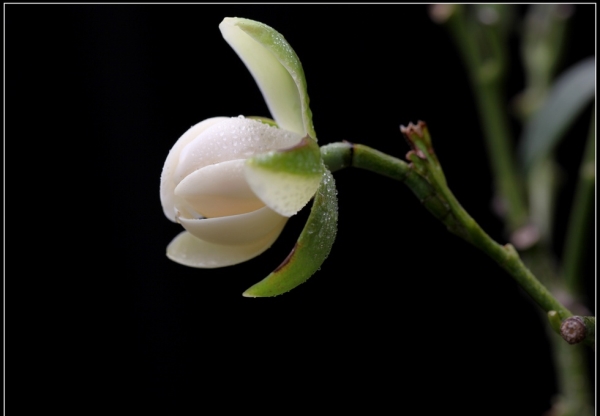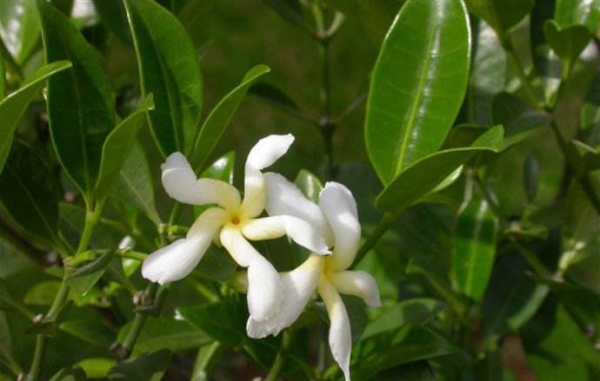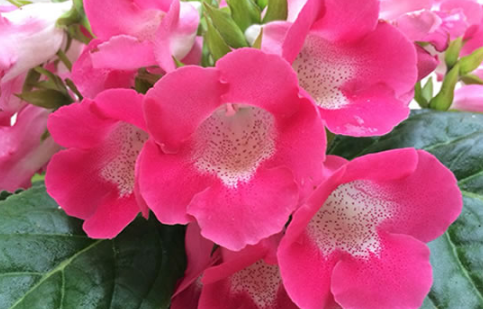The culture method of night flower
Light
Night flowers like to grow in a warm, humid and sunny environment, but they also need proper shade on hot summer days.
Soil
Night lily is suitable for planting in well-drained, fertile and slightly acidic sandy soil, avoiding calcareous soil but also resistant to barren soil and arid climate.

Fertilizer application
Night flowers like fertilizer, in its flowering period should be timely replenishment of nutrients, fertilizer once a week.
Watering
The night flower should not be watered too frequently to prevent the root rot caused by stagnant water at the bottom. Can often spray water to the leaves, in the form of fog without water flow, to prevent root rot.
The above is about when the night flowers bloom and how long the flowers bloom. Night flowers in summer out of green and white globular florets, with a higher appreciation value, with it to decorate the living room and bedroom is undoubtedly a very good choice!
How to raise the night flower the culture method of the night flower
Night lilies, also known as magnolia, bright green leaves, beautiful flowers, fragrance overflowing. The night flowers bloom early in the morning, and the flowering period of each flower is only 1-2 days. How to raise the night flowers? What is the method of breeding? Let's take a look at the breeding methods of night flowers.
First, how to raise the night lilies
The night lilies are native to China. Like warm, humid and sunny environment, strong adaptability to climate and soil, shade tolerance, good fertilizer. Like to grow in a warm, humid and half-yin and half-yang environment. Should be well drained, fertile, slightly acidic sandy soil, avoid calcareous soil, but also resistant to barren soil and arid climate. Flowers bloom for a short time, each blooming for only 1-2 days, often open early in the morning and closed at night, hence the name Night Flower. The fragrance is sweet and fragrant, and it is even stronger at night. The optimum temperature at flowering stage was 22-25 ℃, and flowering was delayed when the temperature was lower than 20 ℃.
II. Culture methods of night flowers
1. Reproduction: the nocturnal flower is generally propagated by the method of connection and high-altitude striping, and the method of high-altitude striping is suitable for breeding after the weather turns warm in early spring or in autumn. After the rooting is moved into the nursery, the large seedlings can be raised, and the survival rate is relatively high. 90% or more.
2. Potted soil: mountain mud is the best when planting night flowers in potted plants. Remember that calcareous soil can not be used for cultivation. The soil must be acidic, and the best PH value is 5.5-8.5. As a family bonsai, you can generally use 6 parts of vegetable garden soil and 4 parts of river sand mixed with half a spoonful of black alum.
3. Watering: the water conditions of night flowers are usually watered once every two or three days in spring, because the northern spring is relatively dry, which is easy to cause the leaves to yellowing, so it is best to continuously irrigate alum fertilizer 3 times every two or three days for 4 times. in summer, because of the dry and hot weather, we need to spray water frequently to increase the humidity of the air, and after autumn, we should water less and increase the light.
4. Fertilization: it is suitable for pruning and shaping dead and dislocated branches in autumn. In winter, the temperature should be kept between 10 and 12 degrees Celsius in winter, and not less than 5 degrees Celsius or more than 10 degrees Celsius at night, so as not to be harmful to hibernation and affect the flowering of the following year. During the growing period, rotten cake fertilizer should be applied every 15 days, nitrogen fertilizer should be stopped before flowering, and more phosphorus and potassium fertilizer should be applied to promote the fragrance of flowers. No fertilizer is needed for indoor maintenance in winter.
5. Pest control: common leaf blight harm of night lily can be sprayed with 65% zinc wettable powder 600 times. Pests are harmful to leaf beetles, aphids and shell insects, which are sprayed with 1000 times of 50% fenitrothion EC.
The above is the introduction of night flower breeding methods, night flowers small and exquisite, flowers overflowing, can be used as a potted ornament, as a living room and bedroom decoration oh.
Culture methods and matters needing attention of Nightflower
Latin name Magnolia coco (Lour.) DC.
The plant kingdom.
Phylum angiosperm
Dicotyledonous class
Ranunculus
Magnoliaceae
Magnolia
Distribution area South China and Vietnam
Night lilies, also known as magnolia, is native to southern China. Like warm and humid and half-yin and half-yang environment, shade-resistant, afraid of hot sun exposure, requires fertile, loose and well-drained slightly acidic soil, winter temperature is not lower than 5 ℃. Evergreen shrubs, 1-2 m tall. 1. Morphological characteristics.
Evergreen shrubs or small trees, 2-4 m tall, glabrous in all parts of the plant; bark gray, branchlets green, smooth, slightly angular and glossy. Leaves leathery, elliptic, narrowly elliptic or Obovate-elliptic, 7-14 (- 28) cm long and 2-4.5 (- 9) cm wide, apex long acuminate, base cuneate, dark green shiny above, slightly wrinkled, margin slightly revolute, lateral veins 8-10 on each side, mesh sparse; petiole 5-10 mm long; stipules scar to tip of petiole. Pedicel pendulous, with 3-4 bract deciduous scars. Flowers globose, 3-4 cm in diameter, tepals 9, fleshy, Obovate, ventral concave, outer 3 pieces greenish, with 5 longitudinal veins, about 2 cm long, inner two whites pure white, 3-4 cm long and 4 cm wide; stamens 4-6 mm long, anthers ca. 3 mm long, connective protruding into mucronate tips; filaments white, ca. 2 mm long; pistil green, ovate, 1.5-2 cm long Carpels ca. 10, narrowly ovate, 5-6 mm long, abaxially with 1 longitudinal groove to style base, stigma short, apex truncate after shedding; aggregate fruit ca. 3 cm long; follicles subwoody; seeds ovoid, ca. 1 cm high, endocarp brown, ventral tip with lateral foramen, sulcus inconspicuous, base pointed. Flowering in summer, continuous flowering in Guangzhou throughout the year, and autumn in fruit.
2. Growth environment
The night lilies are native to China. Like warm, humid and sunny environment, strong adaptability to climate and soil, shade tolerance, good fertilizer. Like to grow in a warm, humid and half-yin and half-yang environment. Should be well drained, fertile, slightly acidic sandy soil, avoid calcareous soil, but also resistant to barren soil and arid climate. Flowers bloom for a short time, each blooming for only 1-2 days, often open early in the morning and closed at night, hence the name Night Flower. The fragrance is sweet and fragrant, and it is even stronger at night. The optimum temperature at flowering stage was 22-25 ℃, and flowering was delayed when the temperature was lower than 20 ℃.
3. Distribution
Distributed in East China, South China, Southwest China and Liaoning, Hebei, Henan, Shaanxi and other provinces.
4. Cultivation techniques
Breeding methods like moist, fertile soil, shade tolerance, mostly born in the evergreen broad-leaved forest at an altitude of 600m to 900m, and have poor resistance to toxic gases. It is usually propagated by relying on joining method or high-altitude pressing method. Grafting takes Magnolia, Magnolia, Magnolia and Magnolia as rootstocks; high-altitude striping propagation is carried out after the weather turns warm in early spring or autumn, and after rooting, it is moved into the nursery to grow large seedlings before planting. In recent years, cuttings are also often used to cut ears and sand on one-to two-year-old seedlings, and the survival rate can reach 90%.
The cultivation method of potted soil is the best, do not use calcareous soil, the soil must be acidic, PH is 5.58.5. Family planting can also be mixed with 6 parts of vegetable garden soil, 4 parts of river sand, plus half a tablespoon of black alum. After leaving the room in mid-April, the night flower is maintained in a place of astigmatism with a light transmittance of 30 to 40%. Spring 2 to 3 days watering, the northern spring dry, easy to cause leaves yellowing, so every two or three days continuous watering alum fertilizer water three or four times. Summer should be semi-overcast, often spray water, increase air humidity. After entering autumn, we should water less. Gradually increase the light to enrich the plant. Dead branches and dislocated branches are pruned and shaped in autumn. In winter, the room should be placed in a place where there is no direct sunlight, keeping it between 10 and 12 ℃ during the day, not less than 5 ℃ at night, and no more than 10 ℃ at night, so as not to be harmful to hibernation and affect flowering in the following year. Keep the basin soil slightly wet in winter. During the growing period, the rotten cake fertilizer is applied every 15 days or so. Stop applying nitrogen fertilizer before flowering, and apply more phosphorus and potassium fertilizer to promote flower fragrance. There is no need to apply fertilizer for indoor maintenance in winter.
For the control of common leaf blight, 65% zinc wettable powder can be sprayed with 600 times solution. Pests are harmful to leaf beetles, aphids and shell insects, which are sprayed with 1000 times of 50% fenitrothion EC.
5. Main value
Usually planted in gardens or street trees. Wood is resistant to water and moisture and can be used to make furniture; bark contains tannin and fiber can make artificial cypress; seeds can extract oil; bark and flowers can be used medicinally, which can calm the mind, activate blood circulation, relieve pain, and have strong resistance to toxic gases such as sulfur dioxide and chlorine.
Medicinal value
Night flowers ("textual Research on the name and reality of plants")
[synonym] Night Magnolia (Guangzhou Flora).
A nocturnal flower of the Magnoliaceae.
[collection] picked from April to May and dried in the sun.
[chemical constituents] the stem contains oxidized xanthine, willow magnoline, magnoline, sinomenine, tomato branch and leaf alkaloid and nocturnal alkaloid. The alkaloid is in the skin.
[functional indications]
① "Guangdong traditional Chinese Medicine" Ⅱ: "to treat liver depression and qi pain."
② "Guangxi Medicine Plant list": "refuting the bone, tranquilizing the five internal organs. Cure falls, symptoms, leucorrhea of women."
[usage and dosage] Internal administration: fried soup, 1.5 yuan 3 yuan.
[character]
Dry flowers, slightly umbrella-shaped, inverted bell-shaped or irregular spheres, 2-3 cm long, 1-2 cm in diameter, dark red to brownish purple outside. Calyx 3, long Obovate, about 1.5 cm long and 8 mm wide, with granular protuberances on both sides. The petals are 6, Obovate, curled, and the outer 3 are larger, about 2 cm long and 1.2 cm wide, with granular protuberances at the base of the outer surface and smooth, thick and brittle inner neck. Stamens spirally arranged, rosette-shaped, each stamen narrowly oblong triangular, about 6 mm long. The pistil is about 7-8 mm long and consists of 7-8 carpels, which are narrowly angled, purple-brown or brown, with small tubercles. Flower stalk retained dark brown. The breath is extremely fragrant and the taste is light. It is better to have complete flowers and strong fragrance.
Application of ornamental value
The night flower tree is small and exquisite, with green and white globular flowers in summer, day and night closed, delicate and elegant, often planted in parks and courtyards in the south, and potted plants in Nanjing, decorating living rooms and bedrooms with it.
references
1. Magnolia. Chinese Flora [reference date 2013-12-12].
2. Night flowers. China Medical Network [citation date 2013-12-12].
- Prev

The breeding method of Bermudagrass
Soil Bermuda is suitable to grow in fertile, well-drained acidic soil, so we can choose general garden soil or pond mud, do not use alkaline soil or poor water retention soil. The growth of Bermudagrass has a great demand for nutrients, so it is necessary to change the pot frequently to maintain nutrients. It is generally chosen to change the basin every two years.
- Next

What about the yellowing of paulownia leaves?
1. The reason for too much watering: paulownia prefers to be wet, but it can't be watered more. Too much watering will make the leaves yellow and rotten. Solution: big paulownia should be watered less, do not dry, do not water, winter plants enter the dormant period, can stop watering. And can not be watered on the leaves, there are more fluff on the leaves, watering will appear water stains
Related
- Fuxing push coffee new agricultural production and marketing class: lack of small-scale processing plants
- Jujube rice field leisure farm deep ploughing Yilan for five years to create a space for organic food and play
- Nongyu Farm-A trial of organic papaya for brave women with advanced technology
- Four points for attention in the prevention and control of diseases and insect pests of edible fungi
- How to add nutrient solution to Edible Fungi
- Is there any good way to control edible fungus mites?
- Open Inoculation Technology of Edible Fungi
- Is there any clever way to use fertilizer for edible fungus in winter?
- What agents are used to kill the pathogens of edible fungi in the mushroom shed?
- Rapid drying of Edible Fungi

